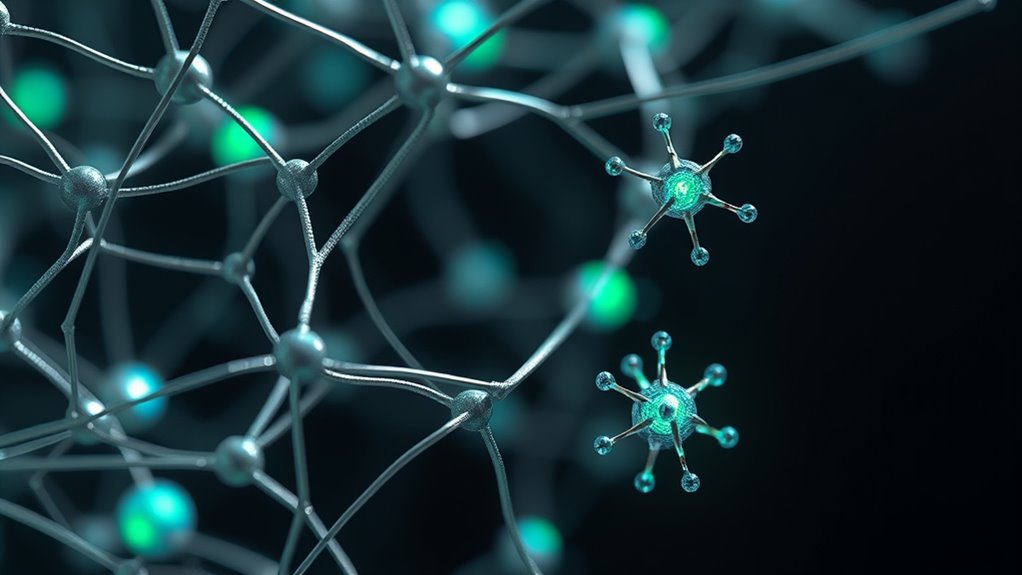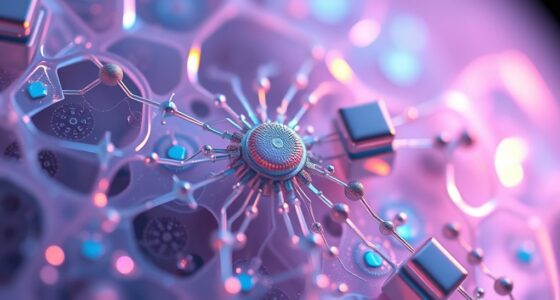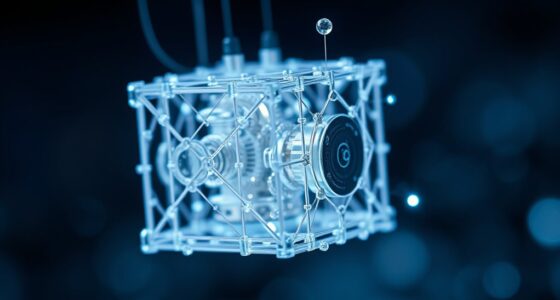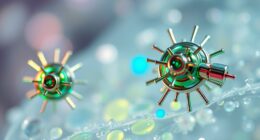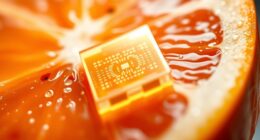Chemical sensing nanomachines detect molecules with precision by mimicking biological systems and using engineered nanoscale structures. They rely on molecular docking and active sites to recognize specific targets, converting interactions into signals like light or electrical changes. Built from materials such as graphene, nanoparticles, and flexible polymers, these sensors offer high selectivity and sensitivity. To discover how advances in technology and applications improve their capabilities, keep exploring these innovative detection methods.
Key Takeaways
- Chemical sensing nanomachines use molecular docking and active sites for highly selective molecule recognition.
- Advanced nanoscale fabrication positions recognition elements for precise detection in complex environments.
- Signal transduction methods, like optical and electrical detection, convert molecular interactions into measurable responses.
- Materials such as graphene, metal nanoparticles, and biocompatible polymers enhance sensitivity and specificity.
- Applications include healthcare, environmental monitoring, and food safety, enabling real-time, accurate chemical detection.
The Fundamentals of Chemical Sensing Nanomachines
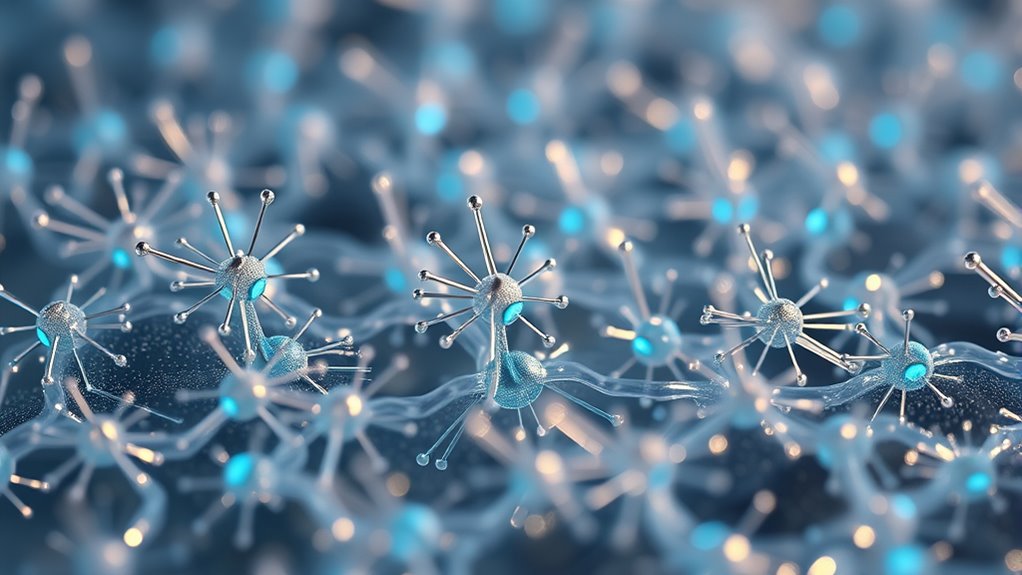
Understanding the fundamentals of chemical sensing nanomachines is essential to grasp how they detect and respond to specific chemical signals. At their core, these nanomachines rely on molecular docking, where target molecules bind precisely to specialized active sites. This process mimics natural biological systems, allowing nanomachines to identify specific chemicals with high accuracy. The fabrication of these nanodevices involves advanced techniques to build nanoscale structures capable of supporting molecular docking and signal transduction. During fabrication, materials are engineered to optimize surface properties and binding affinities, ensuring reliable detection. Additionally, the surface chemistry plays a crucial role in enhancing the selectivity and sensitivity of nanomachines, aligning with the importance of surface properties in their effectiveness. By mastering nanomachine fabrication and understanding molecular docking principles, you can appreciate how these tiny devices operate at the molecular level, laying the foundation for their ability to sense chemicals with remarkable precision.
How Nanomachines Detect Specific Molecules

Once nanomachines are fabricated with precise active sites, their ability to detect specific molecules depends on how effectively these sites recognize and bind to their targets. Molecular engineering allows you to design these active sites with high specificity, tailoring their shape, charge, and chemical properties to match target molecules. Nanoscale fabrication ensures these recognition elements are positioned accurately, optimizing interaction strength. When a molecule binds to the active site, it triggers a measurable response—such as a change in electrical conductivity or fluorescence—that signals detection. By combining molecular engineering with advanced nanoscale fabrication, you can create nanomachines capable of distinguishing between similar molecules, enabling precise, selective sensing even in complex environments. This synergy is fundamental to the development of highly accurate chemical sensors. Advances in automation are also playing a role in scaling up production and testing of these nanomachines.
Materials and Components Used in Construction

What materials are essential for constructing effective nanomachines? You need materials that enable precise nanoscale fabrication and guarantee safety within biological environments. Biocompatible materials are vital to prevent adverse reactions and maintain functionality in vivo. For the structural framework, you might use carbon-based nanomaterials like graphene or nanotubes for strength and conductivity. To enable sensing capabilities, metal nanoparticles such as gold or silver are common due to their optical properties. Polymers and lipids are often used for flexible, biocompatible coatings. Additionally, you need specialized sensors built from organic molecules or inorganic compounds tailored for molecular recognition. These components work together to create efficient, durable, and safe nanomachines capable of precise chemical detection. Incorporating high contrast ratios in the design can also enhance the visibility of sensor signals, improving detection accuracy and reliability.
Mechanisms of Molecular Recognition

How do nanomachines identify and bind to specific chemical targets with high precision? It all comes down to synthetic receptor design, which creates tailored binding sites that match target molecules. These receptors use shape, size, and chemical complementarity to guarantee selective recognition. Molecular docking plays a key role in this process, allowing you to simulate and optimize how the receptor interacts with the target. By modeling these interactions, you can predict binding affinity and specificity, ensuring the nanomachine binds only to the desired molecule. This combination of synthetic receptor design and molecular docking enables highly precise recognition, minimizing false positives and enhancing detection accuracy. The result is a sophisticated recognition mechanism capable of identifying molecules even in complex environments.
Techniques for Signal Transduction and Data Collection
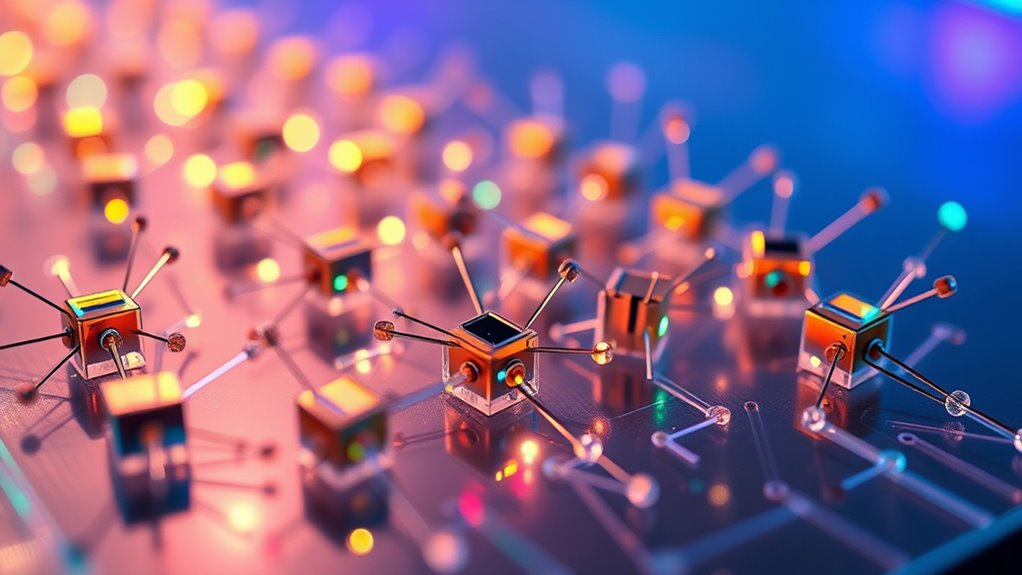
You can convert molecular interactions into measurable signals through various techniques. Optical methods generate light signals, while electrical measurements track changes in current, providing real-time data. Effective data processing then interprets these signals, making sense of complex information from your nanomachines. Incorporating life lessons from quotes can inspire innovative approaches to data analysis and problem-solving in this field.
Optical Signal Generation
Optical signal generation in chemical sensing nanomachines involves converting molecular interactions into detectable light signals, enabling precise data collection. You harness quantum effects and optical fluorescence to achieve this, where molecules emit light upon excitation. These nanomachines can be designed to:
- Use quantum effects to enhance signal sensitivity
- Rely on optical fluorescence for real-time detection
- Minimize background noise through selective light emission
- Integrate nanostructures that amplify fluorescence signals
- Enable rapid data acquisition with high spatial resolution
Electrical Current Measurement
Building on the foundation of optical signal generation, electrical current measurement provides an alternative approach for detecting molecular interactions in chemical sensing nanomachines. You leverage techniques like quantum tunneling and electron tunneling to measure tiny changes in electrical current caused by molecular binding events. When a molecule interacts with the nanomachine, it can alter the tunneling barrier, affecting the flow of electrons between electrodes. These variations are detected as current shifts, offering high sensitivity and rapid response times. By monitoring electron tunneling, you can precisely identify specific molecules based on their influence on electrical conductance. This method enables real-time, label-free detection, making it ideal for applications requiring rapid and accurate chemical analysis at the nanoscale.
Data Processing Techniques
Effective data processing techniques are essential for translating the electrical signals generated by chemical sensing nanomachines into meaningful information. You can enhance this process through data fusion, combining signals from multiple sensors to improve accuracy and robustness. Machine learning algorithms play a pivotal role, enabling you to identify patterns, classify signals, and filter noise efficiently. To optimize data collection, consider techniques like feature extraction, real-time filtering, and dimensionality reduction. These methods help you manage complex datasets and improve detection sensitivity. By integrating data fusion with machine learning, you can develop smarter systems that adapt to environmental changes and improve molecule detection precision. Ultimately, these techniques empower you to turn raw signals into actionable insights with speed and reliability.
Applications in Healthcare and Disease Monitoring
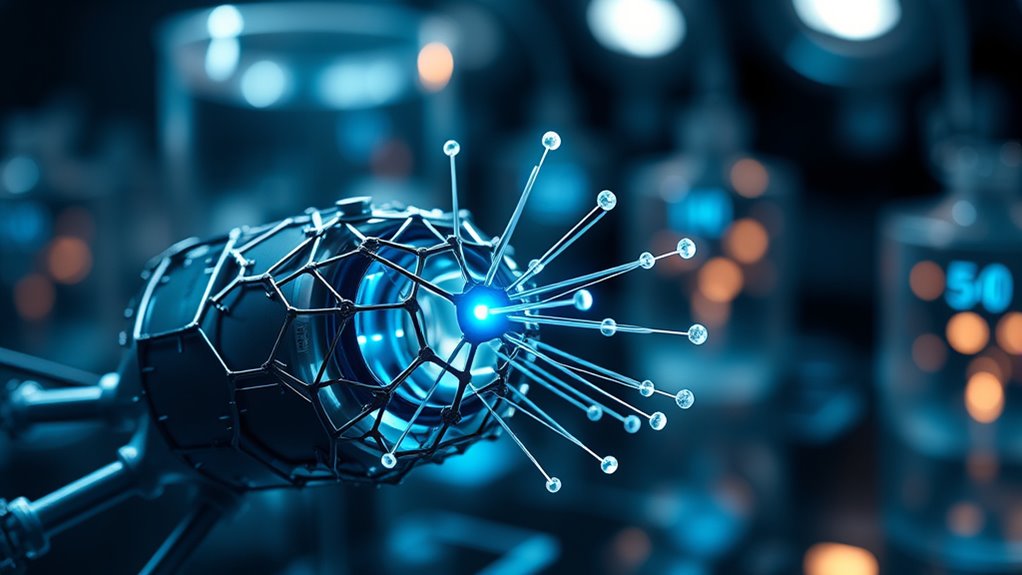
Have you ever wondered how tiny sensors can revolutionize healthcare? Chemical sensing nanomachines enable real-time, precise disease detection and monitoring by integrating biologically with tissues and fluids. These devices can identify biomarkers at very low concentrations, providing early diagnosis and personalized treatment. Their biological integration allows seamless communication within the body, reducing invasiveness and improving patient comfort. Additionally, the development of research-driven, plain-English articles helps demystify complex scientific concepts for a broader audience. However, deploying these nanomachines requires careful attention to regulatory considerations, ensuring safety and efficacy. Regulatory agencies evaluate their biocompatibility, long-term stability, and potential side effects before approval. As a result, these nanomachines hold the potential to transform healthcare, offering continuous health monitoring, early disease detection, and better management of chronic conditions with minimal discomfort.
Environmental Monitoring and Pollution Detection

Ever wondered how we can detect environmental pollution quickly and accurately? Thanks to nanomachine miniaturization, you can now deploy tiny sensors capable of environmental toxin detection with high precision. These nanomachines can navigate complex environments, pinpoint pollutants, and provide real-time data. Their small size allows for discreet, widespread monitoring without disrupting ecosystems. When used for pollution detection, they can identify harmful substances like heavy metals, pesticides, and industrial chemicals early on. Here’s what makes them effective:
- Enhanced sensitivity to low concentrations
- Rapid response times
- Ability to operate continuously
- Targeted detection of specific toxins
- Integration into portable sensing networks
Moreover, advancements in Mazda Tuning have demonstrated how precise modifications can optimize vehicle performance, paralleling how nanomachines are tailored for specific environmental targets.
Food Safety and Quality Assurance
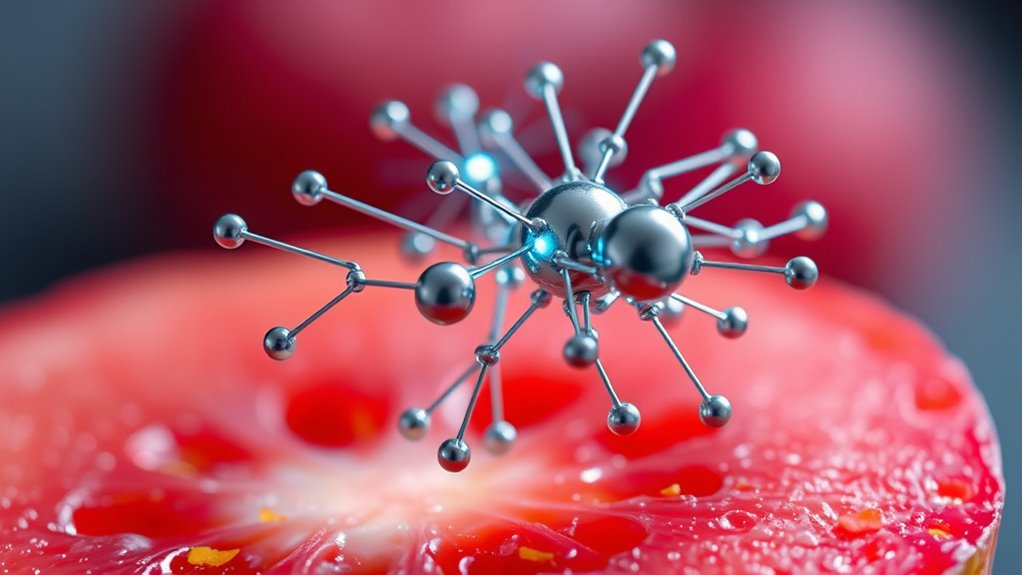
Nanomachines are revolutionizing food safety and quality assurance by enabling precise, real-time detection of contaminants. Thanks to nanomachine miniaturization, these devices can navigate complex food matrices and identify harmful substances at the molecular level. By employing advanced molecular targeting strategies, nanomachines selectively bind to specific toxins, bacteria, or chemical residues, ensuring accurate detection. This approach minimizes false positives and accelerates response times compared to traditional testing methods. With their small size and high specificity, nanomachines can be integrated into packaging or processing lines, continuously monitoring food quality. Additionally, the use of cutting‑edge skincare technology principles allows for even more sophisticated detection capabilities. As a result, you gain a reliable tool that enhances safety standards, reduces waste, and protects consumer health through rapid, on-site analysis.
Challenges and Limitations in Nanomachine Development
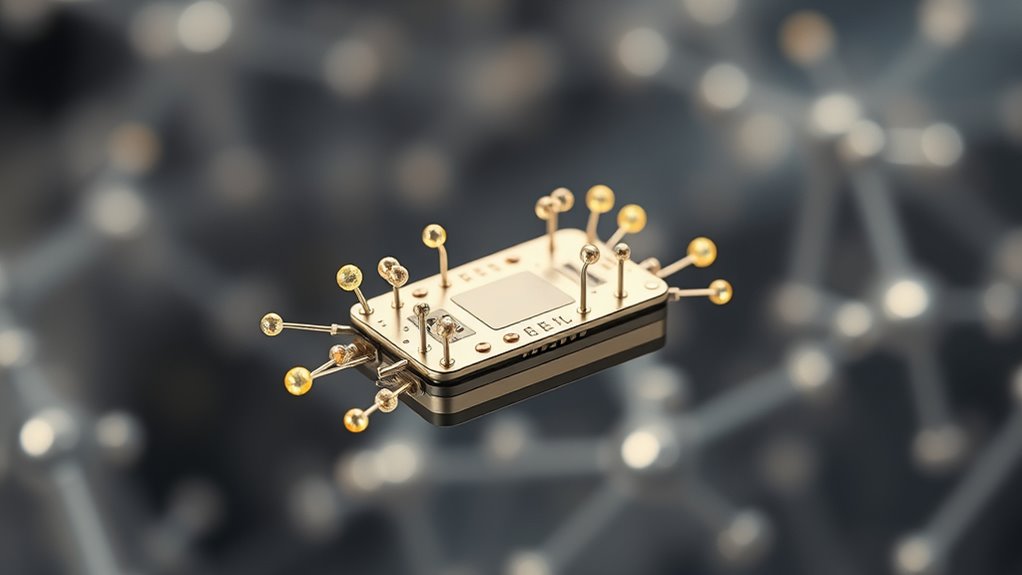
Developing nanomachines faces significant hurdles like manufacturing at scale, which can be challenging and costly. You also need to find the right balance between sensitivity and selectivity to guarantee accurate sensing without false alarms. Additionally, power sources and control mechanisms remain limited, affecting how effectively these nanomachines can operate in real-world environments. Ensuring proper ventilation considerations is crucial for maintaining optimal performance and safety.
Manufacturing Scale Constraints
Scaling up the manufacturing of nanomachines presents significant challenges because their precise construction at such a tiny scale requires advanced techniques and strict control over materials. Achieving consistent quality across large batches is difficult due to variability in fabrication processes. Here are key issues you face:
- Maintaining high batch consistencyduring mass production
- Ensuring uniformity of nanostructures at scale
- Controlling material properties tightly
- Overcoming limitations of current nanofabrication methods
- Managing cost and time efficiency in large-scale production
These constraints hinder widespread deployment of nanomachines, making it tough to balance precision with scalability. Overcoming manufacturing scale constraints is critical to advancing nanomachine technology and enabling reliable, commercial applications.
Sensitivity and Selectivity Balance
Achieving the right balance between sensitivity and selectivity remains a core challenge in nanomachine development. High sensitivity allows you to detect even trace molecules, but it can increase false positives due to noise or non-specific binding. Conversely, improving selectivity often reduces sensitivity, risking missed detections. Quantum effects play a pivotal role here; they can enhance signal transduction at the nanoscale but also introduce unpredictable behaviors that complicate tuning. Additionally, biofouling prevention is essential to maintain nanomachine performance, as unwanted biological material can obscure signals and reduce selectivity. Striking this balance demands precise engineering of surface chemistry, sensor design, and understanding of quantum phenomena. Overcoming these limitations ensures you develop nanomachines capable of accurate, reliable chemical sensing in complex environments.
Power and Control Limitations
Power and control limitations pose significant hurdles in nanomachine development, as managing energy supply and precise manipulation at such small scales is inherently challenging. High power consumption can lead to overheating and reduced operational lifespan, while ineffective control algorithms may cause erratic movements or failure to target molecules. You must optimize energy use and develop advanced control methods to ensure stability. Consider these factors:
- Minimizing power consumption to extend device lifespan
- Designing efficient control algorithms for accurate navigation
- Balancing energy needs with sensing precision
- Overcoming miniaturization constraints in energy storage
- Ensuring reliable command execution despite limited power
Addressing these issues requires innovative solutions to provide stable power and precise control, making nanomachines more effective in chemical sensing applications.
Future Directions and Emerging Technologies
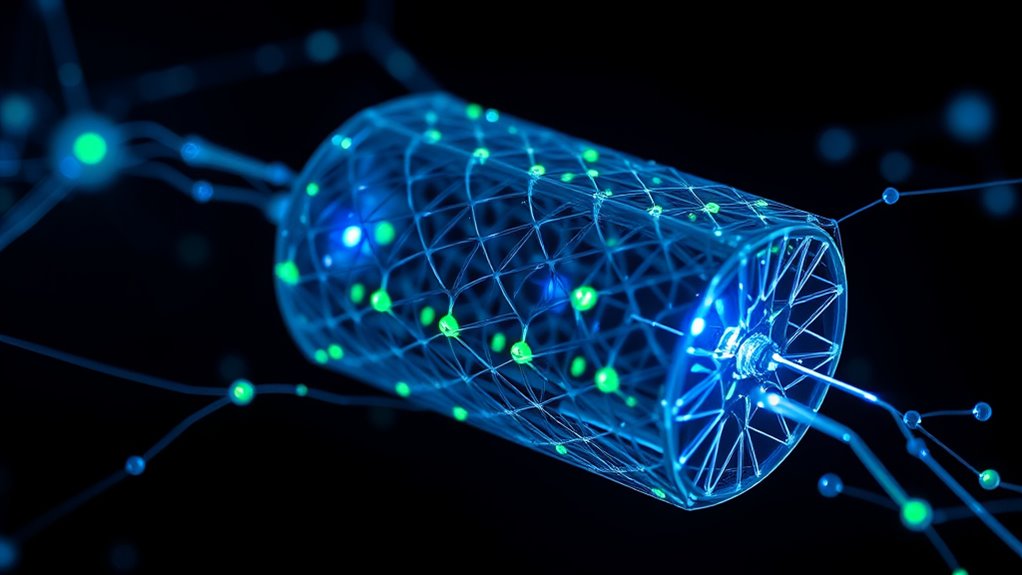
As research progresses, emerging technologies are poised to revolutionize the capabilities of chemical sensing nanomachines. Quantum tunneling offers potential for highly sensitive detection, enabling nanomachines to identify molecules with unprecedented precision. This phenomenon allows for rapid, energy-efficient sensing at the atomic level, expanding detection limits. Additionally, advancements in nanorobot navigation will improve how these devices traverse complex biological environments, ensuring more accurate targeting and data collection. Future innovations might combine quantum tunneling sensors with advanced navigation algorithms, allowing nanomachines to move precisely within tissues or fluids. These developments will enhance real-time monitoring, personalized medicine, and environmental sensing. Moreover, addressing AI vulnerabilities will be essential to ensuring the safety and reliability of these sophisticated sensing systems as they become more integrated into critical applications. As these technologies mature, you’ll gain tools that are more adaptable, efficient, and capable of addressing complex chemical detection challenges with remarkable accuracy.
Frequently Asked Questions
How Do Nanomachines Differentiate Between Similar Molecular Structures?
You leverage molecular recognition and selective binding to differentiate similar molecules. Your nanomachines use specialized receptors or binding sites tailored to unique molecular features, like shape or charge. When a molecule fits precisely into these sites, binding occurs, allowing you to identify it accurately. This high specificity guarantees that even closely related structures are distinguished based on subtle differences, making your sensing process precise and reliable.
What Are the Energy Sources Powering Nanomachines During Detection?
You power nanomachines through energy harvesting, capturing energy from their environment like light, heat, or chemical reactions. This harvested energy is managed by sophisticated power management systems, ensuring the nanomachines operate efficiently during detection. By utilizing ambient sources, these tiny devices avoid the need for batteries, allowing continuous sensing and precise molecular detection without external power supplies.
Can Nanomachines Operate Effectively in Complex Biological Environments?
Think of nanomachines as tiny explorers steering a bustling city. They can operate effectively in biological environments, but biocompatibility challenges and signal interference are hurdles. These issues can cause miscommunication or harm, so designing nanomachines that harmonize with the body’s natural systems is vital. With careful engineering to reduce interference and enhance biocompatibility, you can guarantee these nanomachines perform reliably in complex biological settings.
How Is Data Security Ensured During Molecular Detection Processes?
You guarantee data security during molecular detection by implementing advanced encryption protocols that protect sensitive information from unauthorized access. You also focus on maintaining data integrity, verifying that the data remains unaltered throughout the process. By integrating these measures, you can confidently transmit and store detection results, preventing tampering or interception, and ensuring that the nanomachines’ data remains secure and reliable in complex biological environments.
What Are the Environmental Impacts of Deploying Nanomachines at Scale?
You should know that deploying nanomachines at scale could pose significant environmental risks; studies suggest that even tiny particles can accumulate in ecosystems, affecting ecological effects. About 30% of nanomaterials may persist in the environment longer than expected, potentially harming wildlife and water quality. While these innovations offer benefits, you must consider the ecological effects and implement strict regulations to minimize adverse impacts on ecosystems.
Conclusion
Think of chemical sensing nanomachines as tiny explorers steering through a vast jungle of molecules. With precision tools and keen senses, they seek out specific targets amid chaos. As your guides, they help you uncover hidden truths about our environment, food, and health. But like any explorers, they face challenges. Embrace their potential, and together, you’ll chart a future where nanomachines reveal nature’s secrets with unmatched clarity.
